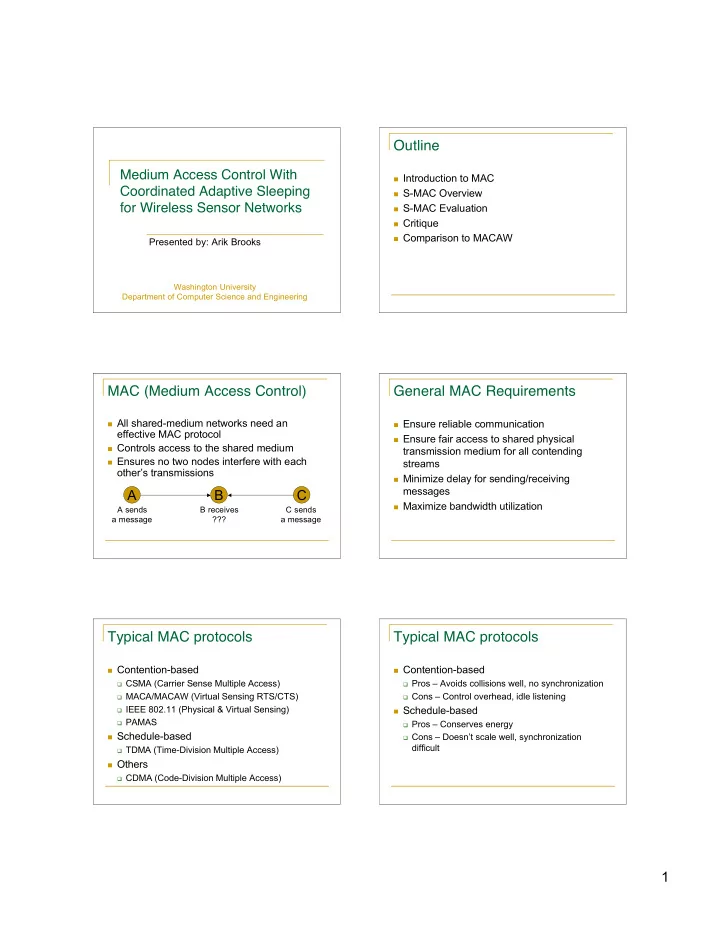

Outline Medium Access Control With Introduction to MAC Coordinated Adaptive Sleeping S-MAC Overview for Wireless Sensor Networks S-MAC Evaluation Critique Comparison to MACAW Presented by: Arik Brooks Washington University Department of Computer Science and Engineering MAC (Medium Access Control) General MAC Requirements All shared-medium networks need an Ensure reliable communication effective MAC protocol Ensure fair access to shared physical Controls access to the shared medium transmission medium for all contending Ensures no two nodes interfere with each streams other’s transmissions Minimize delay for sending/receiving messages A B C Maximize bandwidth utilization A sends B receives C sends a message ??? a message Typical MAC protocols Typical MAC protocols Contention-based Contention-based CSMA (Carrier Sense Multiple Access) Pros – Avoids collisions well, no synchronization MACA/MACAW (Virtual Sensing RTS/CTS) Cons – Control overhead, idle listening IEEE 802.11 (Physical & Virtual Sensing) Schedule-based PAMAS Pros – Conserves energy Schedule-based Cons – Doesn’t scale well, synchronization difficult TDMA (Time-Division Multiple Access) Others CDMA (Code-Division Multiple Access) 1
MAC Requirements for S-MAC: Design Wireless Sensor Networks Energy Efficiency Uses elements of contention-based and schedule-based MAC protocols Scalability/Adaptability to network size, density, and topology Tries to reduce energy waste from all major sources Less emphasis on fairness, latency, Collisions, Overhearing, Control packet overhead, throughput, and bandwidth utilization Idle Listening Trades performance for energy efficiency Increases per-hop delay Reduces fairness Sources of Energy Waste S-MAC: Low Duty-Cycle Operation Collisions Low duty-cycle operation Re-transmitting packets takes a lot of energy Reduces idle-listening by putting nodes to sleep most of the time Overhearing However, increases latency, which can Receiving packets destined to other nodes accumulate on each hop Control packet overhead Sending/Receiving control packets Idle Listening Listen Sleep Listen Sleep L… An idle radio consumes almost as much power as during reception S-MAC: Coordinated Sleeping S-MAC: Listen Schedule Uses Coordinated Sleeping to reduce control Listen broken into slots for SYNC, RTS, CTS overhead and latency Nodes adopt their neighbors sleep schedule If conflicting schedules, nodes can adopt both or Receiver Listen just remember the second for transmit SYNC RTS CTS Rx Data/Sleep Only initiate communication during awake time, during which neighbors should also be awake Transmitter Periodically broadcast SYNC message to Tx SYNC Tx RTS Rx CTS Tx Data … maintain sync CS CS Periodic neighbor discovery (listens to whole sync period) 2
S-MAC: Collision Avoidance S-MAC: Message Passing Sending Long Messages is costly in terms of Collision and Overhearing Avoidance energy and latency Uses physical AND virtual carrier sense Re-transmission of a long message is costly RTS/CTS/Data/Ack Transmitting many small fragments requires extra All nodes that hear a RTS or CTS sleep for the overhead specified TX time to avoid overhearing/collision Message Passing used to minimize costs of Inspired by PAMAS sending a long message Use a single RTS/CTS for all fragments, reducing Sender Receiver control packet overhead A B C D E F Re-transmission limited to corrupted fragments S-MAC: Example w/o Adaptive S-MAC: Adaptive Listening Listening Uses Adaptive Listening to minimize delay A B C D Nodes that hear RTS/CTS wake up and Schedule Schedule listen for a short time immediately after the Wake Wake previous transmission should have ended A Tx Data CS Not as good as it sounds because RTS/CTS Added RTS CTS ACK B Rx Data packets exchanged during adaptive wakeup CS Delay period are not during the next packets wake CTS RTS CTS C time D CTS S-MAC: Example with Adaptive S-MAC: Energy Performance Listening Two-hop network A B C D Savings due to avoiding overhearing and Schedule Adaptive Schedule Wake Wake Wake efficiently transmitting Adaptive long messages A Tx Data Wake CS B RTS CTS ACK Added Source 1 Sink 2 Rx Tx Data CS A E Delay C CTS RTS CTS ACK C Rx CS CS B D D CTS RTS RTS CTS Source 2 Sink 1 Not Seen Not Seen 3
S-MAC: Energy Performance S-MAC: Latency Performance … … 1 2 3 10 11 1 2 3 10 11 Source Source Sink Sink Lowest Traffic Load Highest Traffic Load S-MAC: Throughput Performance S-MAC: Energy-Time Cost Performance … … 1 2 3 10 11 1 2 3 10 11 Source Source Sink Sink Highest Traffic Load Another Traffic Load Key Ideas Critique/Questions Combines advantages of contention-based The authors dismiss fairness as an important part of (good collision avoidance) and schedule- the MAC protocol because of an unsubstantiated based (energy efficiency) assumption about the nature of wireless sensor network applications Low-duty cycle with coordinated sleeping How does S-MAC compare to other MAC protocols RTS/CTS/Data/Ack when awake designed for energy efficiency (TDMA, etc…)? Overhearing avoidance based on info in Do schedules ever combine or get reformed to RTS/CTS packets synchronize more groups of nodes? This doesn’t Adaptive sleeping used to reduce latency seem to meet the requirement of being flexible to compared to other schedule-based protocols network changes 4
Comparison to MACAW Where to learn more MACAW http://www.isi.edu/scadds/projects/smac/ Designed to improve fairness, throughput, latency, and General info and links related to S-MAC reliability http://www.isi.edu/ilense/software/smac/ RTS-CTS-DS-DATA-ACK Download source code Dynamic backoff algorithm (lower if contention level is low) S-MAC FAQ Designed to improve energy efficiency http://www.isi.edu/~weiye/pub/commstack.pdf Adds coordinated sleep for energy conservation Detailed description of the modified comm stack Backoff algorithm is random sleep used to implement S-MAC on TinyOS Uses fragmentation to reduce control overhead 5
Recommend
More recommend